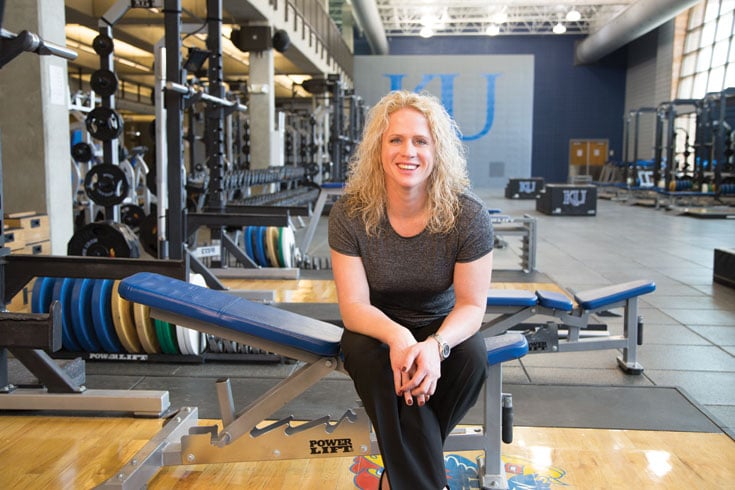
Our guest post this week comes from Andrea Hudy at The University of Kansas. Hudy joined the Jayhawks in 2004, after a 9 year tenure at The University of Connecticut. In her time with the Jayhawks, 25 of her athletes have gone on to the NBA. Kansas was the first collegiate program to use the Sparta Software and have been integral in the development of the system.
At Kansas we have always prioritized recovery techniques. Since teaming up with Dr. Phil Wagner and Sparta Science, we have been able to validate and incorporate more specific recovery work and explain the benefits to our athletes.
The recovery techniques that we use are designed to offset fatigue and sport specific adaptations (over-use), that are sometimes good for performance but not for the long-term health of the athlete. Using the Sparta Software and Force Plate, we can evaluate the trends of an athlete’s movement pattern over time and understand how they react to certain training, practice and recovery loads. For example, as a season progresses, repetitions accumulate and we often see decreases in power, strength, rate of force development, focus, increased stiffness, etc. Mobility and soft tissue work are great tools to offset the general fatigue and stiffness that compromises an athlete’s desired movement pattern and/or range of motion. In addition, the Sparta Software allows us to precisely understand how we can tailor our strength and recovery techniques to meet the athlete’s specific needs.
Our basketball players tend to fall into a few general Sparta signatures. More specifically, players are usually categorized by one of two signatures. The first is that they lack mobility (too stiff). These players tend to be guards and are unable to flex/extend and lack compliance, but have good reactive strength. In Sparta terms, they have low DRIVE. They tend to be susceptible to bone and ligamentous injuries in the lower body, specifically the foot, lower leg and hip.
The ‘bigs’ have the opposite problem/ Sparta Signature, lacking overall strength (indicative of improper sequencing). They lack specific basketball sequencing as well as bracing and posturing techniques. They have high DRIVE, but need to develop their LOAD and EXPLODE. These players hinge at the hip instead of bending at the ankle which limits their rate of force development. In a perfect world we would strive to create a basketball player with high EXPLODE, followed closely by DRIVE then LOAD.
The patterns we see with untrained elite basketball players can be explained by sport specific adaptations that occur on the court, and which can be unhealthy if the athlete doesn’t train correctly in the weight room. Unfortunately in today’s world, young athletes are driven to early specialization in sports that typically favor late specialization. Also, collegiate recruiting creeps earlier and earlier each year, fueling the desire for complete mastery of one’s craft. But these athletes are practicing harder, not smarter. What we see by the time they reach collegiate athletics is that the benefits they think have derived from high repetitions of sport specific skills have actually created large imbalances. They are not performing the proper exercises to be healthy within their sport.
For example, basketball players come into the weight room tight, stiff and fatigued from year-round practice and competition. In order to produce the healthiest, highest functioning athlete possible, we have to throw out the idea of sport specific training (short, ballistic repetitions) and opt for un-sport specific exercises (long, slow, healthy repetitions). Basketball is an anterior chain (ankle, knee) dominant sport that also demands an upright posture. That makes the athletes’ muscles in the foot tight, and calves stiff, both of which limit ankle mobility. Also, the quads are tight which can anteriorly tilt the pelvis, put a pre-stretch on the hamstring and cause low back pain. Accordingly, we opt for prescribing more un-sport specific exercises that actually work to increase performance and reduce injury risk by developing mobility to dissipate forces more efficiently.
How can we simply and effectively coach these athletes to develop more healthy habits?
For starters, we instill the idea that mobility is good for EVERYBODY. Mobility requires coordination, and through deliberate recruitment of the neuromuscular system, we can teach our athletes how to control quality movement through proper ranges of motion. More precisely, we focus on the areas that pose a high risk of injury for basketball players. Starting with the foot, we work through entire ranges of motion: flexion, extension, and torsion. We increase soft tissue quality in the foot by rolling out using different sizes hard rubber balls. We then target the calf with a lacrosse ball, vibrating foam roller, and bands to passively work on terminal knee extension. Working our way up the quad tendon, through the quad to hip flexor and groin, the athlete finishes with work on the psoas.
The Sparta Software has validated our exercise prescriptions to help us create an athlete who is more efficient, requiring less loading with higher output, so that long-term health and performance can be obtained.
by Andrea Hudy and Ali Kershner